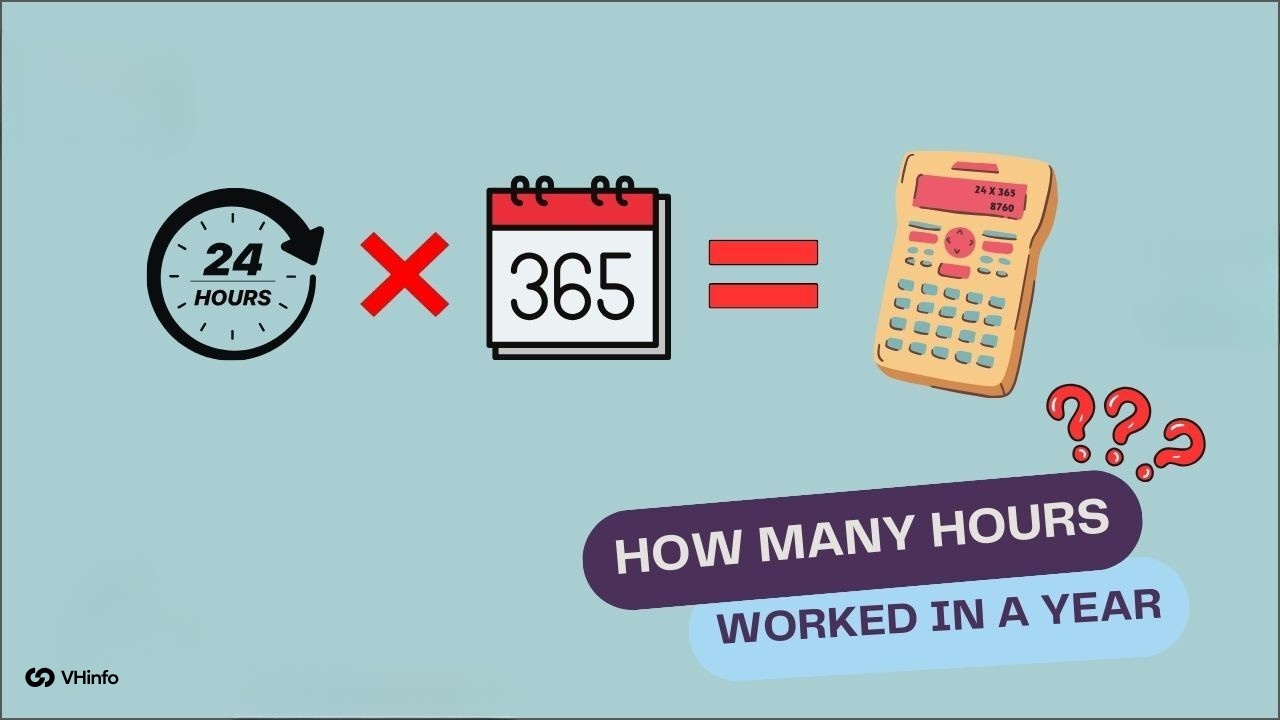Have you ever wondered how much time you spend at work over a whole year? Knowing the number of work hours you have can be very useful. It helps you understand your pay, plan your free time, and see how your job fits into your life.
Calculating your working hours for the calendar year might seem hard, but it’s simpler than you think.
This guide will walk you through everything, from the basic math to the different things that can change the total number of hours you work. We will look at how public holidays, vacation time, and sick leave affect your total time at work.
How Many Work Hours In A Year?

Figuring out the number of work hours in a year starts with a few simple numbers. The standard is based on a typical job in the United States.
The 40-Hour Workweek Standard
Most full-time jobs in the U.S. are based on a 40-hour work week.
This became common because of the Fair Labor Standards Act, a law that sets rules for jobs, including minimum wage and overtime pay. This means that many time employees are expected to work eight hours a day, five days a week.
These weekly working hours are the foundation for calculating the total annual work hours.
Total Weeks in a Year (52 Weeks)
A year has 52 weeks. This number of weeks is key to finding the annual work hours.
Whether it’s a normal year or a leap year, we use 52 weeks as the standard for our calculation. A leap year adds an extra day, which can slightly increase the number of work days, but the weekly count stays the same for this basic formula.
The Basic Formula For Annual Work Hours
To get the basic number of hours worked in a year, you multiply the weekly hours by the number of weeks in a year.
40 hours per week x 52 weeks per year = 2,080 hours
So, the standard work year has 2,080 working hours. This is the starting point for almost everyone. However, this total number doesn’t account for time off, which we will look at next. The actual amount of time you spend working is usually less.
Factors That Affect Your Total Work Hours In A Year

The 2,080-hour figure is just an average. The actual total work hours for a person can change a lot. Several factors can reduce your yearly work hours, giving you more personal time. Other factors, like overtime, can increase them.
Federal and Public Holidays
Most people don’t work every single day of the work year.
In the United States, there are several federal holidays when many people get a paid holiday. Federal employees get these days off, and many private companies follow the same schedule. These holiday hours reduce your annual working hours.
The main public holidays in the U.S. include:
- New Year’s Day
- Martin Luther King, Jr.’s Birthday
- Presidents’ Day
- Memorial Day
- Juneteenth National Independence Day
- Independence Day
- Labor Day
- Columbus Day
- Veterans Day
- Thanksgiving Day
- Christmas Day
If you get 10 holidays off, that’s 80 hours (10 days x 8 hours/day) that you don’t work. This brings your total working hours down from 2,080 to 2,000.
Paid Time Off (PTO) and Vacation Days
Paid time off, or PTO, is a benefit where your employer pays you even when you’re not working. This includes vacation days.
The average number of paid vacation days can vary.
If you take two weeks of vacation, that’s another 80 work hours (10 days x 8 hours/day) off your yearly hours. This gives you more vacation time to relax and recharge. The more PTO hours you have, the fewer annual hours you’ll work.
Sick Leave and Personal Days
Sick leave is time off you can take when you are not feeling well. Personal days are for other things you need to do, like going to an appointment. Many companies offer a certain number of days for sick days each given year. Taking this time also reduces your total hours.
This time is important for your health and mental health. Using five sick days would reduce your work schedule by another 40 hours.
Overtime Hours
Sometimes, you might work more than your standard 40 weekly work hours. This extra time is called overtime hours.
According to the Fair Labor Standards Act, many hourly employees must receive overtime pay for any hours worked over 40 in a week. These extra hours increase your total annual work hours. If you work five overtime hours every week, you would add 260 hours to your work year.
Good project management can help companies avoid too much overtime.
Average Annual Work Hours Around the World

The idea of a 40-hour work week is not the same everywhere. The average hours people work can be very different depending on the country.
Let’s compare the annual working hours in a few places.
Comparing Work Hours in the US, UK, and Canada
According to data from the International Labor Organization, the average annual work hours vary across developed nations.
- United States: In the United States, people work an average of 1,976 hours per year. This is close to the 2,080-hour standard before accounting for time off.
- United Kingdom: Workers in the UK have fewer working hours, averaging around 1,867 hours per year.
- Canada: In Canada, the average number of annual work hours is lower still, at about 1,669 hours per year.
These differences show how culture and laws can affect how much time people spend at work.
Countries With the Most Annual Work Hours
Some countries have a much higher number of work hours.
According to 2024 data, workers in Bhutan work the most, with around 2,829 hours per year. Other countries with long weekly working hours include the United Arab Emirates, Lesotho, and Qatar.
In these places, the work week is often longer, and there may be fewer paid vacation days..
Countries With the Fewest Annual Work Hours
While some countries have very long workweeks, others have much shorter ones. These countries often prioritize a better work-life balance. As of 2025, Yemen has the shortest average workweek in the world, at just 25.9 hours.
Several European nations are known for having fewer working hours. The Netherlands is famous for its focus on work-life balance, with an average workweek of only 26.8 hours. Other countries with low annual work hours include :
- Norway (27.1 hours per week)
- Austria (28.4 hours per week)
- Denmark (28.8 hours per week)
- Finland (28.8 hours per week)
These countries show that high productivity can be achieved with fewer hours at work. Strong social policies, flexible work schedules, and generous paid vacation days contribute to this balance, leading to happier and more efficient workforces.
How to Calculate Your Personal Work Hours For the Year?

You can calculate your own yearly work hours pretty easily. The method is slightly different for hourly and salaried employees.
Step-by-Step Guide For Hourly Employees
If you are an hourly employee, your pay is directly tied to the number of hours you work. Here’s how to calculate your total hours.
- Track Your Daily Hours: Write down when you start and end work each day.
- Subtract Unpaid Breaks: Be sure to subtract any unpaid time, like a 30-minute lunch break.
- Calculate Weekly Hours: Add up your hours for each day to get your weekly hours.
- Multiply by Weeks Worked: Multiply your weekly total by the number of weeks you work in the calendar year.
For example, if you work 38 weekly hours for 50 weeks (after taking two weeks of unpaid vacation), your total work hours would be:
38 hours/week x 50 weeks = 1,900 hours
Knowing your hourly wage helps you calculate your total pay from this number.
Calculating Hours For Salaried Employees
For salaried employees, the process is a bit different. You start with the standard 2,080 hours and subtract your time off.
- Start with 2,080 Hours: This is your baseline annual hours.
- Subtract Holidays: Count the number of days you have for public holidays and multiply by 8. (e.g., 10 holidays x 8 hours = 80 hours).
- Subtract Vacation Time: Do the same for your vacation days. (e.g., 15 vacation days x 8 hours = 120 hours).
- Subtract Sick Leave: Finally, subtract your sick days. (e.g., 5 sick days x 8 hours = 40 hours).
2,080 – 80 (holidays) – 120 (vacation) – 40 (sick) = 1,840 hours
This gives you a much more accurate picture of your total working hours.
Tools and Calculators For Tracking Work Hours
Keeping track of your work hours can be made easier with tools. Simple spreadsheets or online work hours calculators can do the math for you. These tools help with time management and make sure you’re paid correctly. For business owners, tracking employee hours is essential for payroll and is something the Department of Labor and the Bureau of Labor Statistics monitor.
At VH Info, we believe that making your work effective is just as important as tracking it. Our services help SaaS companies improve their online strategies so that every work hour counts toward growing their business.
FAQ’s:
How Do Holidays and Paid Time Off Affect Total Yearly Work Hours?
Holidays and paid time off reduce the total number of work hours you are actively working in a given year. Even though you are paid for this time, you are not on the job. Each paid holiday or vacation day you take subtracts from the 2,080-hour standard, giving you more free time.
What is the Calculation For Annual Work Hours If I Am Not Full-Time?
If you are a part-time employee, you use the same formula but with your specific number of hours. Simply multiply your average weekly work hours by 52. For example, if you work 25 hours per week, your annual work hours would be 25 x 52, which equals 1,300 hours.
How Many Work Weeks Are There In A Typical Year in the US?
There are 52 work weeks in a typical year in the United States. This is the standard number used for most calculations related to work hours. A leap year has 366 days instead of 365, which adds one extra day to the calendar year, but the number of full weeks remains 52.
Conclusion
The standard work year contains 2,080 work hours, based on a 40-hour work week multiplied by 52 weeks.
However, this number is just a starting point. Your actual total work hours will likely be different once you account for public holidays, vacation days, sick leave, and any overtime hours you may work. The average hours also change from one country to another.
Calculating your personal annual working hours helps with financial planning and promotes good time management. For business owners and salaried employees alike, knowing this total number provides clarity on your work-life structure.
At VH Info, we focus on helping SaaS brands make their time more valuable with effective link-building strategies that drive growth.


